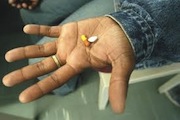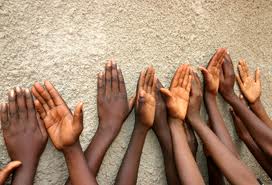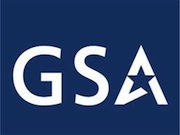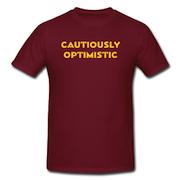New HIV Treatment Guidelines & Other Updates

I am not usually an overly cautious man — just look at the way I dress! However, the revised HIV Treatment Guidelines from the Department of Health and Human Services have given me pause. I find myself both cautiously optimistic, and honestly have some concerns.
Cautiously Optimistic
The new guidelines recommend that all HIV positive Americans start Antiretroviral (ARV) therapy soon after diagnosis. Previously, ARVs were recommended for People Living with HIV (PLWH) whose CD4 counts fell below 500.
While the ultimate decision about when to start treatment remains in the hands of the individual and his or her doctor, the new guidelines make the panel’s recommendation about when to start treatment very clear. No longer are we dependent on CD4 counts that can fluctuate. In some ways, it may eliminate HIV-related health disparities and may result in more health care professionals feeling confident about their ability to treat PLWH.
Honest Concerns

The new guidelines did not wait for the results of the Strategies for Management of Anti-Retroviral Therapy (SMART) study. This study was supposed to determine the best time to start therapy. Treatment as Prevention (TasP) is an essential component of our efforts to end the HIV/AIDS epidemic; however, without the science of the SMART study, I am concerned that the guidelines were changed because of the excitement around TasP’s potential without waiting for the results from this study.
While it’s not the function of the panel, I am also concerned about our ability to pay for treatment.
According to the Centers for Disease Control and Prevention (CDC), there are around 1.2 million Americans living with HIV, just over 941,000 of them are aware of their status. Currently just over 328,000 HIV positive Americans have an undetectable viral load. If we follow the new guidelines and just use the PLWH already identified, approximately 613,000 individuals will need to start/reassess their ARV therapy. Some of them are already on treatment, but have not achieved viral suppression because they are on suboptimal treatment. The medications alone could cost as much as $8,500,000,000 per year
Until the Patient Protection and Affordable Care Act is fully implemented, enrolling this many new individuals onto treatment poses significant challenges. Most people who have private insurance or are enrolled in Medicaid or Medicare will get these life extending drugs. Still, others will be able to take advantage of the Pre-existing Condition Insurance Programs set up under the ACA to help individuals with chronic conditions receive care before all of the law’s provisions are implemented. However, many people who fall between these programs will need to rely on the AIDS Drug Assistance Program (ADAP). We still have a waiting list for this program and we don’t know how many PLWHs were dropped from state’s ADAP programs due to changes in eligibility.
While ADAP funding has increased steadily each year, support for the rest of the Ryan White Care Act (RWCA) remains relatively flat, with Part D receiving a significant cut in President Obama’s 2013 budget request. Many communities do not have the capacity to expand services for an additional 613,000 consumers without significant increases in funding. Yet during these tough economic times, Congress does not seem willing to appropriate the resources necessary to cover this many new PLWH seeking ARVs even though treatment is recommended by the new guidelines.
From the beginning, the National Minority AIDS Council (NMAC) has said it would be impossible to implement TasP without the full implementation of the Patient Protection and Affordable Care Act. Our current system is at a breaking point. It cannot absorb an additional 613,000 HIV-positive Americans without additional resources.
My nightmare scenario is that the results of the SMART study show a different starting point to begin therapy. More likely, we enroll many more people onto ARVs, only to find out we don’t have the funds to pay for the drugs. As a result, healthcare providers may still need to counsel PLWH on starting treatment only when they have consistent access and can remain adherent causing unnecessary stress and worry within communities that are already stressed and worried. Can you imagine means testing for the ADAP program? While we need treatment on demand for PLWH, we recommend caution as communities move forward to implement these new treatment guidelines.
Other Updates:
New Orleans Regional Dialogue to End AIDS In Louisiana
NMAC recently held its very first regional dialogue in New Orleans, Louisiana. The most important thing that I took away from the New Orleans Dialogue was the very real desire to talk about “ending the epidemic.” From health departments, community based organizations, consumers, FQHCs, healthcare providers, researchers, community foundations and pharmacy representatives, the dialogues validated the importance of these discussion.
A full report will be available at this year’s Summit to End AIDS on the first day of the United States Conference on AIDS (http://www.2012USCA.org). However, I want to share some of my observations now:
• The Voice of Consumers is essential for ending the HIV/AIDS epidemic. However, there were many challenges. PLWHA are not as organized as in the “old days.”
• Federally Qualified Health Centers (FQHC) are open to a dialogue with the HIV/AIDS community. Using “ending the HIV/AIDS epidemic” as a way to open doors for discussions focused on implementation of the Affordable Care Act (ACA) and the potential value of referring clients between agencies is a great place to start.
• Essential Health Benefits Package (EHB) and Louisiana’s implementation of the ACA will be sketchy at best. The dialogue showed the need to get the HIV/AIDS community more involved in the discussions. They also need policy support that outlines items that need to be in their state’s EHB.
• Rural issues continue to be a challenge. The difference was highlighted because during Hurricane Katrina, PLWH who fled New Orleans found many of the medications and services they received at home were not available in rural parts of the state. Will the ACA balance out those differences? Also there were concerns about the distance consumers in rural areas would have to travel to receive services from an FQHC (Federally Qualified Health Center). Health care access is more than having access to health insurance.
• The Ryan White Care Act was discussed extensively. Louisiana needs to understand implementation of the ACA and the benefits in the state’s EHB before talking about wrap around services needed in a new reauthorized Ryan White Care Act.
• Community Foundations are very interested in supporting efforts to “end the HIV/AIDS epidemic.” They may also be willing to bring our ideals to other donors. However, donors have very short attention spans and they want a “win.”
• AIDS Educations & Training Centers (AETC) really need to be part of these discussions. Their representatives put us on notice and they have a lot of expertise they can share.
• Pharmacies have a rich data base. They collect non identifying data that could add significant value to our discussions.
• State Health Departments keep information on state Medicaid and Medicare clients. Even if we can’t get this data from the feds, we may be able to integrate non identifying data from the State Health Departments.
NMAC’s next dialogues are in Los Angeles and Washington, DC. Separate discussions will occur with the National Alliance of State and Territorial AIDS Directors (NASTAD) & Urban Coalition of HIV/AIDS Prevention Services (UCHAPS).

USCA Target Population: Women, particularly African American Women & Latinas
NMAC will be hosting a conference call with leaders from the Women’s community to get their input on this year’s conference and to put together a Women’s Advisory Committee. Some of the items we will discuss include:
Tone of Meeting
• This year’s USCA needs to be especially supportive of the needs of women
• Need to tell the story of women’s leadership within the HIV movement in words & pictures
• Opening Plenary on Women & HIV
• Conference Bag that benefits a women’s PLWH organization
• Majority of Special Scholarships given to young women and women living with the virus
• We understand this meeting is in Las Vegas, but it’s not about Las Vegas.
History of HIV Specific Women’s Organizations
• 30 by 30
• Black Women’s Health Imperative
• Chicago Women’s AIDS Project
• Iris Center
• Iris House
• Global Network on Women and AIDS
• National Black Women’s HIV/AIDS Network
• National Women and AIDS Collective
• New Jersey Women & AIDS Network
• Project Azuka
• SisterLove
• Sisters Together & Reaching
• US Positive Women’s Network
• WARN (Women’s AIDS Resource Network)
• The Well Project
• Women Alive
• Women’s Health Collective
• WORLD
• Others?
Potential Seminars/Workshops
• HIV Leadership within the African American, Latina, Asian & Pacific Islander, Native American & Alaskan Native Women’s Community
• HIV Leadership within the Women’s Community
• Understanding the ISIS Study Results
• Vaginal and Rectal Microbicides
• Sexual and Reproductive Health
• Violence Against Women
• PrEP for Women: Why Didn’t It Work?
• Gender-Related Disparities and Services
• Sex Work
• Trans Issues
• Sex Trafficking
Program Book
• Tell the story of different women leaders in the fight against HIV
• Write “Her-story” of Women & HIV
Concerns about The GSA’s Meeting

We take the recent concerns about the General Services Administration’s (GSA) meeting in Las Vegas very seriously. USCA will be a very different meeting from the one held by the GSA.
• No Government Money Pays for Food
No government money will be used to pay for food served at plenary sessions. Food will be underwritten by our corporate sponsors. We thank them for their support.
• No Government Money Pays for Receptions
No government money will be used to pay for receptions. This year we will only have one reception. It will commemorate NMAC’s 25 years of addressing HIV in communities of color. As you may recall, NMAC was founded in Las Vegas and we are returning for our 25th anniversary.
No government money will pay for this reception. This year’s event is being underwritten by Caesars Palace. We thank them for their support.
• No Gifts
USCA does not provide gifts for participants. We will have a conference bag that is produced by a women’s organization to benefit women living with HIV. This year’s bag was underwritten by a corporate sponsor.
• Discount Hotel Room
USCA will have a block of discounted hotel rooms for $60 per night at the overflow hotel, below the government per diem rates! The rooms at the conference hotel are $139 per night.
• Ending the HIV/AIDS Epidemic In America
The first day of this year’s meeting will focus on ending the HIV/AIDS epidemic in America. Each of the following days will focus on different aspects to achieve the goals outlined in the National HIV/AIDS Strategy (NHAS).
• Focus On Skills Building
This year’s meeting will focus on developing the skills necessary to end the HIV/AIDS epidemic. Ending the epidemic cannot happen without training.
• Special Scholarships
This year we will provide scholarships for youth and people living with HIV. A special effort will be made to ensure that the majority of these scholarships go to women and girls, particularly African American women and Latinas.
As you can see, our meeting will be like other USCAs and not like the GSA meeting. We take great pride in being responsible stewards of the funds that we receive and are doing our best to rid the meeting of any wasteful expense and to provide the best learning experience for all attendees. We hope to see you there!
Yours in the struggle,
Paul Kawata
Executive Director

